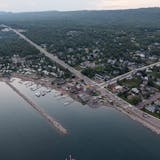Opinion editor's note: Star Tribune Opinion publishes a mix of national and local commentaries online and in print each day. To contribute, click here.
•••
In "Minneapolis businesses, residents at 42nd and Cedar want their on-street parking back," (July 2) the Star Tribune explained how the city of Minneapolis and Hennepin County redesigned an intersection to eliminate 70 on-street parking spaces serving local small businesses. Those neighborhood small businesses are now going to suffer or perish because customers do not have convenient access to them. Jobs will be lost. Wealth will be erased.
Why did these changes happen? Minneapolis adopted its Transportation Action Plan in 2020, which established the ambitious goal that by 2030, 60% of trips in the city would be taken on public transit or by walking, biking or rolling.
The only U.S. city with anywhere near this small percentage of people traveling by car is New York, and Minneapolis will never have the population density or transit options of New York.
Meanwhile, in 2017, the city of Minneapolis had adopted its "Vision Zero" plan, which set the completely unrealistic goal of zero transportation-related deaths by 2027. This was based on a program from Sweden of the same name which has achieved a 15% reduction in transportation-related deaths over the last 25 years. Vision Zero is another catchy Minneapolis slogan, but impractical in the real world.
To achieve the massive decline in auto travel it envisions, the city assumes a more than 10-fold increase in transit use in seven years. What has actually happened with transit ridership? In the eight years prior to the pandemic, local transit ridership declined 25%. And despite the Star Tribune's recent headline, "Metro Transit ridership surges this year," transit ridership is down 40% from pre-pandemic levels.
But reality hasn't deterred the city. In 2018, Minneapolis started reconfiguring city streets as if there would actually be a massive reduction in driving. These physical changes include narrowing streets, eliminating street parking, installing bicycle dividers in the middle of roads, installing bike lanes where there is no demand, bumping sidewalks into the middle of streets, concrete barriers and a myriad of other alterations that have made driving much more difficult.


